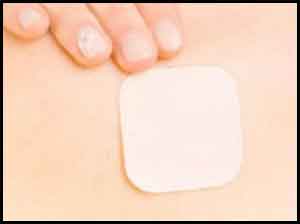- Home
- Editorial
- News
- Practice Guidelines
- Anesthesiology Guidelines
- Cancer Guidelines
- Cardiac Sciences Guidelines
- Critical Care Guidelines
- Dentistry Guidelines
- Dermatology Guidelines
- Diabetes and Endo Guidelines
- Diagnostics Guidelines
- ENT Guidelines
- Featured Practice Guidelines
- Gastroenterology Guidelines
- Geriatrics Guidelines
- Medicine Guidelines
- Nephrology Guidelines
- Neurosciences Guidelines
- Obs and Gynae Guidelines
- Ophthalmology Guidelines
- Orthopaedics Guidelines
- Paediatrics Guidelines
- Psychiatry Guidelines
- Pulmonology Guidelines
- Radiology Guidelines
- Surgery Guidelines
- Urology Guidelines
Painless skin patch collects fluid for diagnostic testing

Although blood contains a wealth of potential biomarkers of disease, it can be challenging to obtain and analyze. There's the anxiety patients experience when a large needle has to be stuck into a vein, and for many tests, technicians need to separate plasma from serum. Now, researchers reporting in ACS Sensors have developed a skin patch containing tiny needles that painlessly collect interstitial fluid for on-patch diagnostic testing.
Interstitial fluid (ISF) is the colorless liquid that fills spaces between cells in the body. This fluid contains some of the same biomarkers found in blood, as well as some unique ones. However, ISF lacks the cells and clotting agents that complicate blood analysis. Recently, researchers developed microneedle patches that can easily and painlessly collect ISF from skin. The fluid collected by the tiny needles goes through a multi-step process of biomarker extraction, centrifugation, sample loading, and analysis to detect biomarkers. Srikanth Singamaneni, Mark Prausnitz, and colleagues wanted to streamline this procedure so that ISF collected by the skin patch could be analyzed directly with surface-enhanced Raman scattering (SERS) -- a technique that can detect and quantify molecules by looking at how nanomaterials scatter light.
The researchers developed a skin patch with nine microneedles, each about the diameter of a human hair and less than 1 millimeter long. The device also included a strip of plasmonic paper that contained gold nanorods coated with a negatively charged polymer that would attract a model analyte, a positively charged dye. The researchers injected the dye into the rats' bloodstreams and then placed the patches on their skin. The dye entered the ISF and from there, the device. The team then analyzed the plasmonic paper with SERS. The new method could detect the dye as sensitively as the previous multi-step procedure, but with much less time and effort.

Disclaimer: This site is primarily intended for healthcare professionals. Any content/information on this website does not replace the advice of medical and/or health professionals and should not be construed as medical/diagnostic advice/endorsement or prescription. Use of this site is subject to our terms of use, privacy policy, advertisement policy. © 2020 Minerva Medical Treatment Pvt Ltd